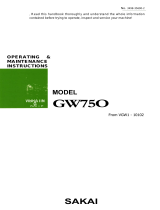
OM EZ17 us 1.0 * ez17us1_0IVZ.fm I-1
Table of Contents
EC declaration of conformity (Yanmar 3TNV76-SNSE12)..................................................................EG-1
Declaration of conformity without CE mark on type label (Yanmar 3TNV76-SNSE12).......................EG-2
1Foreword
1.1 Operator’s Manual................................................................................................................................ 1-1
1.2 Warranty and liability ............................................................................................................................ 1-5
2 Safety Information
2.1 Safety Symbols Found in this Manual .................................................................................................. 2-1
2.2 Warranty............................................................................................................................................... 2-2
2.3 Designated Use.................................................................................................................................... 2-2
2.4 Preparing to use the machine............................................................................................................... 2-3
2.5 Operator and Technician Qualifications and Basic Responsibilities..................................................... 2-6
2.6 Safety instructions Regarding Operation.............................................................................................. 2-6
2.7 Applications with Lifting Gear ............................................................................................................... 2-9
2.8 Attachments........................................................................................................................................ 2-10
2.9 Transport and Towing......................................................................................................................... 2-11
2.10 Safety Guidelines for Maintenance..................................................................................................... 2-11
2.11 Safety Guidelines while using Internal Combustion Engines.............................................................. 2-16
3 Introduction
3.1 Machine overview................................................................................................................................. 3-1
3.2 Brief description of the machine ........................................................................................................... 3-2
3.3 Notices and regulations on use ............................................................................................................ 3-4
3.4 Labels................................................................................................................................................... 3-7
4 Putting into operation
4.1 Cab/control stand ................................................................................................................................. 4-1
4.2 Control element overview................................................................................................................... 4-19
4.3 Indicator lights and warning lights (overview)..................................................................................... 4-24
4.4 Preparatory work ................................................................................................................................ 4-26
4.5 Starting and stopping the engine........................................................................................................ 4-30
5Operation
5.1 Steering system.................................................................................................................................... 5-1
5.2 Accelerator actuation............................................................................................................................ 5-1
5.3 Brakes .................................................................................................................................................. 5-2
5.4 Machine travel ...................................................................................................................................... 5-3
5.5 Differential lock..................................................................................................................................... 5-8
5.6 Lights/signaling system ........................................................................................................................ 5-8
5.7 Wiper/wash system ............................................................................................................................ 5-11
5.8 Heating, ventilation and air conditioning system................................................................................. 5-11
5.9 Work hydraulics.................................................................................................................................. 5-12
5.10 Attachments........................................................................................................................................ 5-37
5.11 Work operation ................................................................................................................................... 5-41
5.12 Emergency lowering........................................................................................................................... 5-46
5.13 Additional equipment/options ............................................................................................................. 5-47
5.14 Decommissioning and putting the machine back into operation......................................................... 5-53
5.15 Final decommissioning of machine..................................................................................................... 5-55
6 Transport
6.1 Towing the machine ............................................................................................................................. 6-1
6.2 Loading the machine ............................................................................................................................ 6-3
6.3 Transporting the machine..................................................................................................................... 6-7
Table of Contents






















